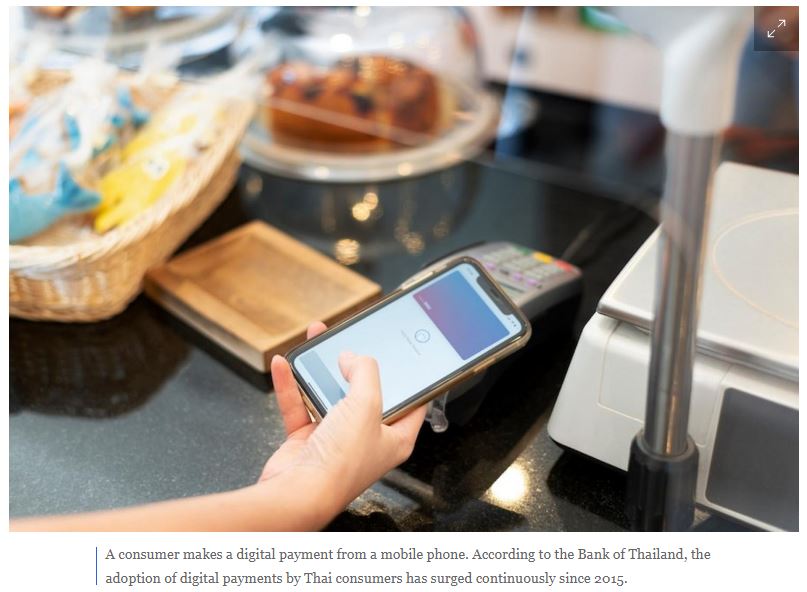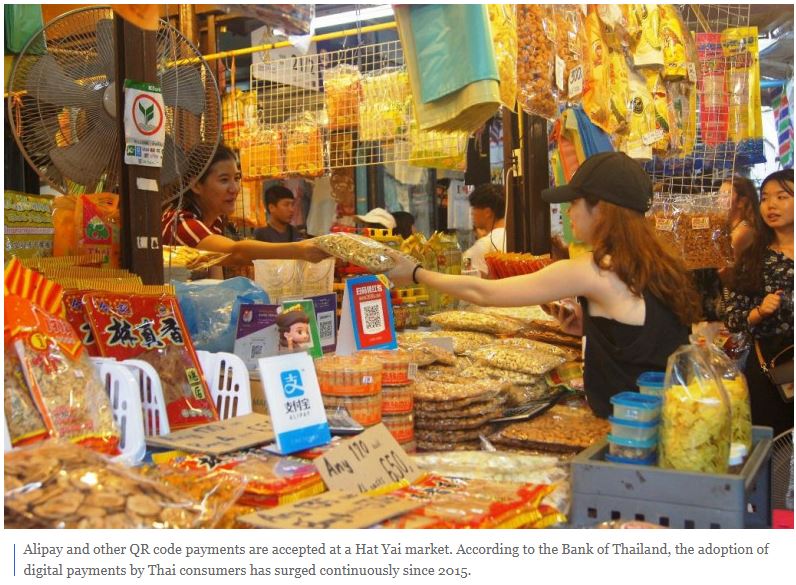Thailand: Rise of online payments accelerates march to cashless society
Former magazine editor Kaysinee Sutthavarangkul never used to give much thought to making cashless payments, as it seemed unlikely to her that every transaction could be made online. But she has changed her buying behaviour since the pandemic.
After seeing her 25-year-old daughter use mobile banking applications, the 61-year-old began making online payments. She has now realised that online channels allow her to explore and connect with sellers whose products were normally difficult to acquire.
“Nowadays, everything is accessible online,” Mrs Kaysinee told the Bangkok Post. “I found the online banking service to be quite convenient. Now I mainly rely on scanning QR codes for my payments,” she said, pointing out that due to her age she started using QR codes only recently.
“To me, becoming ‘cashless’ means ending old habits,” she said, adding that food is among the items she has purchased most online, especially during lockdowns when she started using delivery applications and online shopping.
“Online payments also affect my spending, as every purchase is at my fingertips. I was quite taken aback to see the piles of e-receipts in my phone’s gallery,” she noted.
Mrs Kaysinee is among millions of Thai consumers who now rely on online payments in their daily life. According to Kasikorn Research Center (KResearch), digital payments in Thailand continue to grow, with 95% of total transactions among consumers expected to be paid via online channels this year.
 As Covid-19 continued to spread, payments through digital channels rose above 80% during 2020 to 2021, compared to 2015 when half of payment transactions were still non-online.
As Covid-19 continued to spread, payments through digital channels rose above 80% during 2020 to 2021, compared to 2015 when half of payment transactions were still non-online.
According to the Bank of Thailand, the adoption of digital payments by Thai consumers has surged continuously since 2015. In the first nine months of last year, online payments expanded to 92.4% of total transactions.
Aside from consumer goods used in daily life, financial service providers which include bank and non-bank institutions are facilitating online payments for utility bills and other products, such as investment tools and lotteries.
The expansion of goods and services that can be paid for online, including promotions of e-wallet providers, have also contributed to the growth of digital payments, the study found.
The factors supporting the growth of online payments include consumers’ increasing familiarity with the payment methods, coupled with the government’s policy of developing the online payment system. In particular, more consumers are using QR code scanners on e-wallets or mobile applications from financial service providers to process their payments.
The user base is also widening in terms of age range, as the primary users were previously teenagers and workers.
 As such, Thailand is on course to become a cashless society, with an increasing number of consumers transacting their payments online in 2023, according to data from KResearch.
As such, Thailand is on course to become a cashless society, with an increasing number of consumers transacting their payments online in 2023, according to data from KResearch.
The research house estimated that in 2023, digital payment transactions could total 36.5-37.9 billion baht, representing a 40-45.6% growth from last year. Digital payments, which in this case refers to internet banking, mobile banking, and e-Money, would cover the majority of total transactions whilst non-online payments would see only single-digit growth.
The exponential growth of digital payments in recent years has benefited many retailers, with young entrepreneurs encouraged to launch their own businesses.
They include Naruthai Jongyin, whose online shop sells women’s clothing. “Digital payments have had a positive impact on my business, as it boosts rapid purchases among consumers,” the 25-year-old online merchant said.
Selling on online platforms also helps her business speed up sales, due to a fast-buying process that only takes several clicks.
“Most customers usually complete their payments online on the platform, although a considerable number of them also choose the cash-on-delivery option,” Ms Naruthai said.
Aside from online channels, Ms Naruthai also displays her products at a multi-brand physical store. Nonetheless, she believes brick-and-mortar shops will soon function merely as showrooms.
“I think in the future e-commerce will be a real marketplace where people make their purchases. Creating quality content and optimising ads are key to digital marketing, which to me remains the most important element,” she said.
Last year, the value of the Thai e-commerce market was estimated at 817 billion baht, according to research by price comparison platform Priceza Money.
Amidst the soaring number of users, however, the report identified platforms’ stability as one of the challenges. According to the Bank of Thailand, statistics show that technical failures on mobile banking platforms increased from approximately 10-11 hours in the first quarter of 2022 to 70 hours in the second quarter. The figure dropped to 58-59 hours during the third quarter.
In preparation for a digital economy and another step towards a cashless society, the government will continue to push the agenda with the aim of reducing use of paper-based cheques by half over the next five years, KResearch revealed.
As more Thai consumers increasingly conduct transactions online, financial service providers should therefore ensure stability and safety on their platforms to mitigate risks, the report said.
Source: https://www.bangkokpost.com/business/2480872/rise-of-online-payments-accelerates-march-to-cashless-society


 English
English




